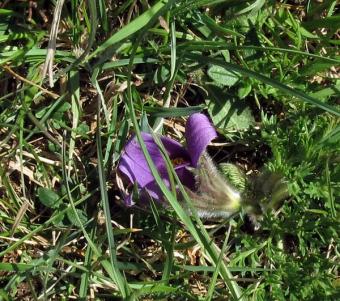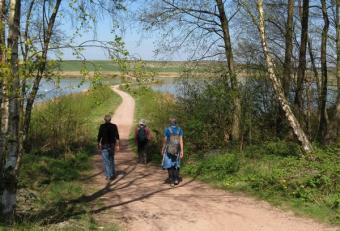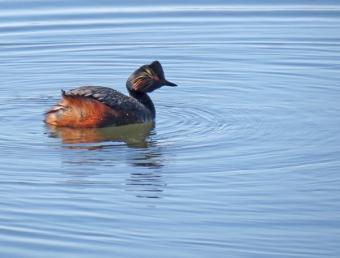 Pasque Flower
Pasque FlowerThe group of 13 began the day by going to the Ledsham site we had visited on Aug 12th last year. The main purpose was to see the very rare Pasque Flower in bloom. This is a plant now so rare it is only known from 19 sites in the whole of the UK and Ledsham is its most northerly outpost. In order to protect the plants from being eaten by mammals, such as rabbits, they are protected by cages which of course makes finding them that much easier.
We were successful much to the delight of our botanists (Joan, Alice & Eric) although there was only a single flower and that was very low to the ground. The concensus was the recent dry weather had delayed emergence and it wasn't yet at its maximum height. Dyer's Greenweed, not yet in flower, was growing nearby.
It was a glorious warm and sunny day with nary a cloud in sight. The type of weather we have come to expect! Both Maddie and Vera (late replacements for Janet and Veronica who were not able to make it) were certainly pleased to be out and about with the group on such a day. Unfortunately for June, she got stuck in traffic and had to abandon her attempt to join us. Orange Tips, Small Tortoiseshells and Peacock butterflies were on the wing. Birds seen included Red Kite, Song Thrush and Chiff Chaff.
We then made our way to the visitor centre at Fairburn Ings which is about 2 miles south of Ledsham. This is where we had our toilet stop and picnic on the outside tables. Robert, one of our regular drivers treated himself to a magnum, so of course I had to follow suit! A couple of Brimstones were seen plus the regular birds around the feeders such as Tree Sparrows.  St AidansAfter an hour we departed for our last destination; Swillington Ings/St Aidans.
St AidansAfter an hour we departed for our last destination; Swillington Ings/St Aidans.
This is a very large site (previously used for opencast coalmining) situated between Leeds, Castleford and Garforth. It is very exposed to the elements, with no tree cover, except around the perimeter and no hides where refuge could be taken. Basically, don't go there if the forecast is a poor one. We entered the site from the western end which is the one opposite the huge mining machine perched high on the eastern slope. On the bank by the side of the parking area we were delighted to see Snakeshead Fritillaries. Black Necked Grebe Presumably garden escapes?
Black Necked Grebe Presumably garden escapes?
We soon split into two groups; botanists and those who didn't want to walk too far stayed along the top bank. A total of 26 flowering species were recorded by Joan in this area and 42 for the day in total. The birders and walkers did a circular walk making use of the causeway; as a whole perimeter walk would have taken up too much time. Birds seen included: 3 Black-necked Grebes, a solitary Pink-foot Goose (spotted by Robert), Reed Buntings, Wigeon, Pipits, Willow Warblers. and Common Tern. Booming Bitterns were heard. A total of 60 birds for the day. No moths or dragonflies though.
We left the site a little after 15:30 and unlike our last trip got back to base in good time.
A splendid day out with thanks to leader Stuart and driver Sue.
John Gavaghan
